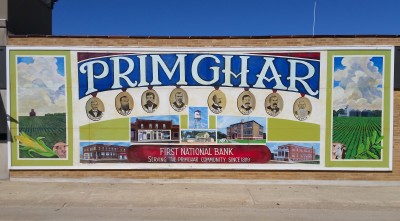
This sign in Primghar identifies the founding fathers for whom the town was named, the first letter of each man’s last name. Photo courtesy of First National Bank in Primghar
By Arvid Huisman
The Native Americans appropriately called Iowa “the beautiful land.”
Iowa has a number of nicknames. For years, our automobile license plates bore the nickname “The Corn State.” Many folks like to refer to Iowa as “The Hawkeye State,” “Beautiful Land” or “The land between two rivers.”
A few decades ago, there was some debate over a new motto: “A State of Minds.”
If you have ever spent any time examining an Iowa map, however, you might come up with a new state motto: “A State of Confusion.”
Iowa is both beautiful and confusing.
The City of Boone, for instance, is located in Boone County, Cherokee is located in Cherokee County, Pocahontas is located in Pocahontas County, Audubon is in Audubon County, Washington is in Washington County, Carroll is in Carroll County and Clinton is in Clinton County.
So why isn’t Union in Union County? Or Monona in Monona County? Or Jefferson in Jefferson County? Or Marion in Marion County?
Osceola is located in Clarke County, not Osceola County, which is in far northwest Iowa. And Emmetsburg is the county seat of Palo Alto County, the first county south of Emmet County. For the record, Clarksville is located in Butler County, not Clarke.
Webster City is the county seat of Hamilton County, the first county east of Webster County where Fort Dodge is the county seat. Hamilton County was once part of Yell County, which was divided into Hamilton and Webster counties. Webster City was originally known as Newcastle. That would have made things less confusing.
Des Moines County is located in southeast Iowa, some 135 miles (as the crow flies) southeast of the city of the same name. And while the Des Moines River flows through Des Moines, the Boone River does not flow through Boone, though it does flow into the Des Moines River (which flows through Boone County) nearly 20 miles north of Boone.
The East Fork of the Des Moines River flows through Kossuth County in northern Iowa but not through Des Moines County. The East Fork flows into the West Fork of the Des Moines in Humboldt County where it becomes the Des Moines River which doesn’t flow through Des Moines County either.
TO READ MORE ABOUT THIS STORY AND OTHER FASCINATING STORIES ABOUT IOWA HISTORY, subscribe to Iowa History Journal. You can also purchase back issues at the store.
